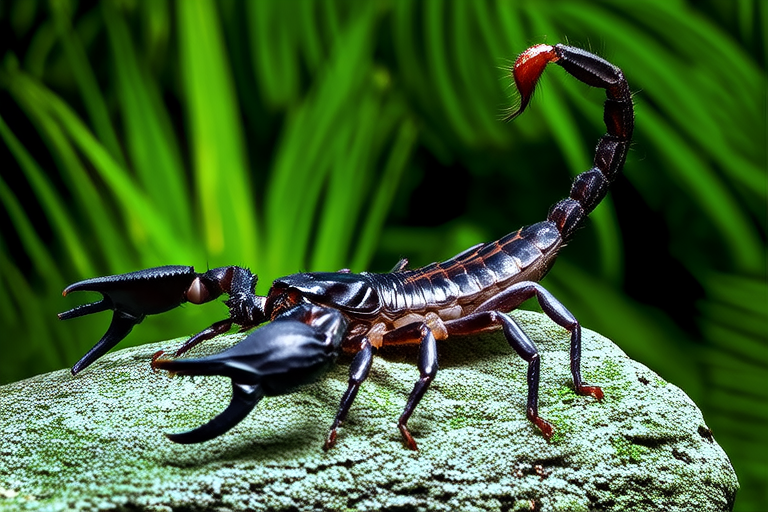Heterometrus spinifer: The Stealthy Predator of Southeast Asia
Heterometrus spinifer, commonly known as the spiny forest scorpion, is a fascinating arachnid native to the lush, tropical landscapes of Southeast Asia. This species is renowned for its unique physical attributes, stealthy hunting tactics, and crucial role within its ecosystem. Understanding Heterometrus spinifer not only provides insight into the intricate web of life in the region but also underscores the importance of preserving these habitats for future generations.
Physical Characteristics
The spiny forest scorpion exhibits a striking appearance that sets it apart from other scorpions. It boasts an elongated body measuring up to 10 centimeters in length, with a pair of large, intimidating pincers at the front. These pincers are equipped with tiny spines, giving the species its name. The tail, adorned with a venomous stinger, curves gracefully over its back, adding to its menacing profile. The coloration varies from dark brown to black, providing excellent camouflage against the forest floor. Additionally, the presence of sensory hairs along its body allows it to detect vibrations and movements, enhancing its predatory prowess.
Habitat and Distribution
Native to the tropical rainforests of Southeast Asia, including countries like Thailand, Malaysia, and Indonesia, Heterometrus spinifer thrives in environments rich with vegetation and humidity. It can be found in dense forests, caves, and even urban areas where human settlements have encroached upon its natural habitat. These adaptable creatures prefer moist, sheltered spots such as under rocks, logs, and leaf litter. The high humidity levels in these regions are essential for maintaining their cuticle’s integrity, preventing dehydration.
Behavior and Hunting Tactics
One of the most intriguing aspects of Heterometrus spinifer is its stealthy approach to hunting. As a nocturnal predator, it relies heavily on its exceptional senses to locate prey. Using its sensitive appendages, it detects the slightest movement or vibration in the surrounding environment. Once a target is identified, the spiny forest scorpion employs a combination of speed and precision to capture its meal. Its venomous sting serves as both a defensive mechanism and a means to immobilize prey. Interestingly, this species has been observed engaging in prolonged battles with larger predators, showcasing remarkable resilience and determination.
Diet and Feeding Habits
The diet of Heterometrus spinifer primarily consists of small insects, spiders, and other arthropods. However, it is not uncommon for this species to tackle prey much larger than itself, demonstrating impressive strength and agility. When hunting, it often waits patiently in ambush positions, hidden beneath leaves or rocks. Upon detecting potential prey, it lunges forward with incredible speed, seizing the victim with its powerful claws before delivering a paralyzing sting. The venom contains neurotoxins that quickly incapacitate the target, making it easier for the scorpion to consume its meal.
Stealthy Predator
As a stealthy predator, Heterometrus spinifer plays a vital role in maintaining ecological balance within its habitat. By preying on various insect species, it helps control populations and prevents outbreaks that could disrupt local ecosystems. Moreover, its presence acts as an indicator of healthy biodiversity, reflecting the overall health of the environment. Despite its fearsome reputation, encounters between humans and this species are rare due to its preference for undisturbed areas.
Interesting Facts
Several fascinating aspects make Heterometrus spinifer stand out among other scorpions. Firstly, unlike many of its relatives, it does not burrow into the ground but instead seeks refuge above the surface. Secondly, females exhibit maternal care by carrying their offspring on their backs until they molt for the first time. This behavior ensures greater survival rates among young scorpions. Lastly, despite being venomous, the toxicity level of their sting is relatively low compared to some other scorpion species, posing minimal risk to humans unless provoked.
Potential Threats and Conservation Challenges
Despite its adaptability, Heterometrus spinifer faces several challenges that threaten its survival. Habitat destruction caused by deforestation, agricultural expansion, and urbanization poses one of the greatest risks. As human activities encroach upon natural habitats, suitable living spaces for these scorpions diminish, leading to population declines. Additionally, climate change may alter rainfall patterns and temperature regimes, potentially affecting the availability of moisture necessary for their survival. Furthermore, illegal collection for the pet trade presents another significant threat, as specimens are sometimes captured and sold without proper regulation.
Importance of Understanding This Species
Understanding Heterometrus spinifer is crucial for several reasons. Firstly, studying its biology and ecology contributes valuable knowledge about the complex interactions within tropical ecosystems. Secondly, recognizing the impact of human activities on this species highlights the broader implications for conservation efforts. Finally, raising awareness about the importance of protecting these habitats fosters a sense of responsibility towards safeguarding biodiversity. By promoting sustainable practices and supporting conservation initiatives, we can help ensure the continued existence of Heterometrus spinifer and other vulnerable species.
In conclusion, Heterometrus spinifer is a remarkable creature that embodies the beauty and complexity of Southeast Asian wildlife. Through its distinctive physical traits, strategic hunting methods, and critical role within its ecosystem, this spiny forest scorpion captures our imagination and reminds us of the delicate balance maintained by nature. As stewards of the Earth, it is imperative that we take action to preserve these precious environments and protect the myriad of life forms they support.
